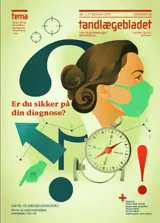Diagnostik – något att tänka på
Om en diagnosmetod ger kvantitativa resultat, exempelvis antalet bakterier i ett salivprov, är det behövligt att definiera ett tröskelvärde som inte enbart indelar patienterna i sjuka och friska, utan också beskriver antalet av patienter med fel diagnos.
Det idealiska sjukdomstecknet är närvarande om patienten är sjuk och frånvarande om patienten är frisk. Det finns emellertid jämt en viss risk att sjuka diagnostiseras som friska och friska som sjuka. Den idealiska fordran är därför sällsynt uppfylld, utan ersättas i klinisk praktik av sannolikhetsvärdering. Sensitivitet och specificitet beskriver en diagnosmetod när den användas på personer som är känd sjuka respektive friska. Prediktiva värden beskriver sannolikheten för att patienten är sjuk respektive frisk vid positiva och negativa testresultat. Om en diagnosmetod ger kvantitativa resultat, exempelvis antalet bakterier i ett salivprov, är det behövligt att definiera ett tröskelvärde som inte enbart indelar patienterna i sjuka och friska, utan också beskriver antalet av patienter med fel diagnos.
Diagnostics –something worse considering
The ideal symptoms or signs are those where their presence indicates disease, and their absence excludes it. There is, however, always a probability that sick persons will be diagnosed as healthy and healthy individuals as sick, and the ideal situation is therefore seldom met, but is replaced in clinical practice by the use of an estimate of probabilities. The terms sensitivity and specificity describes how good a test is when used on either diseased people or healthy people, or simply how good the test is to correctly identified patients with known diagnoses. The term predictive value is used for examination methods which provide a probability that the patient has, or has not a specific diagnosis. With examination methods that provide quantitative results, such as the amount of bacteria in saliva, a threshold value must be defined. This value not only separate persons classified as sick and healthy, but also define the number patients with an incorrect diagnosis.


